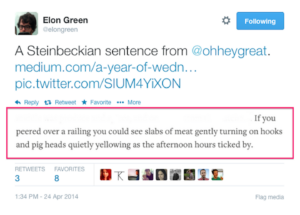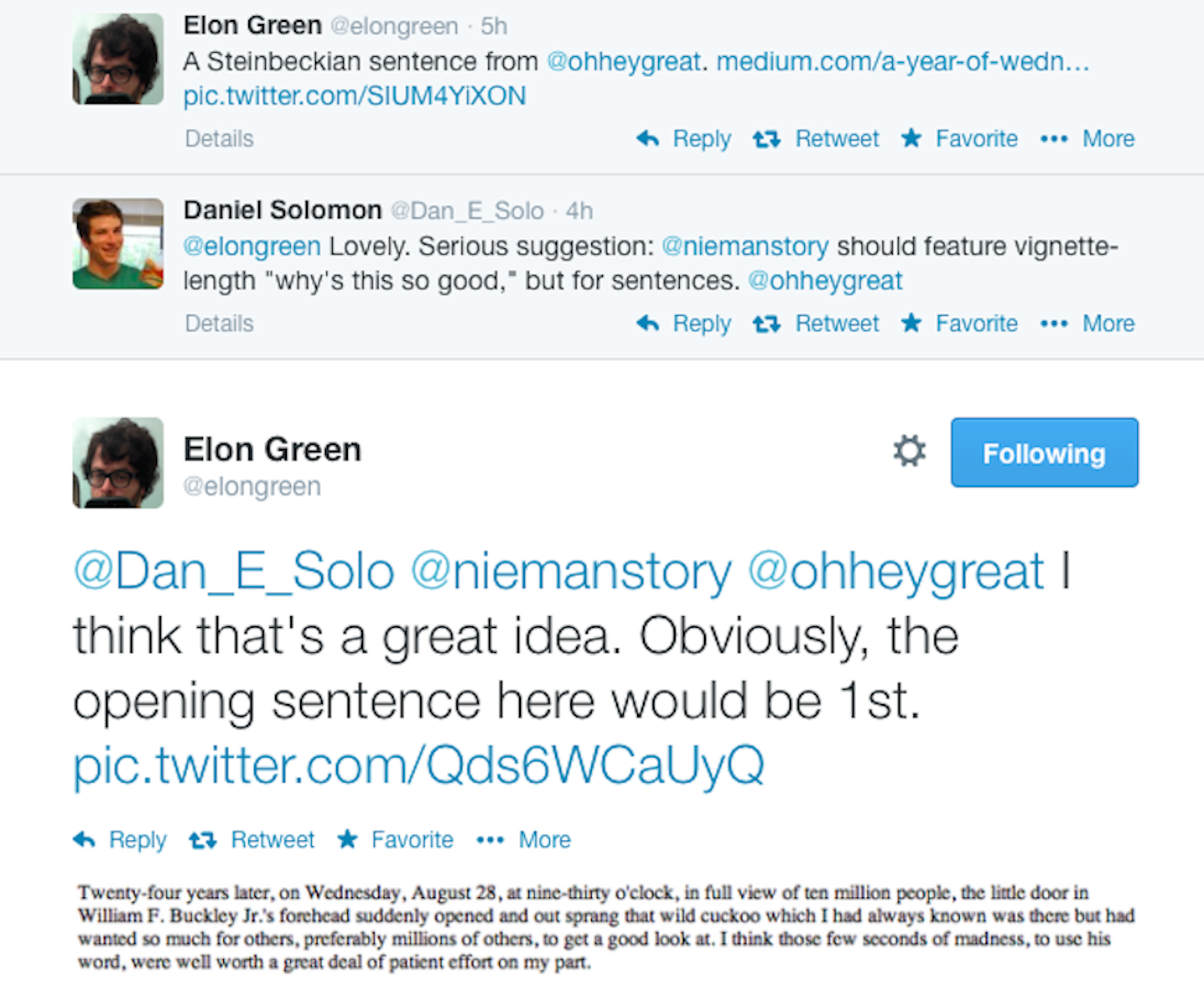The first chapter of How to Write a Sentence (and How to Read One), by Stanley Fish, begins with this paragraph:
The sentence is the beating heart of a story. If story is the corpus, sentence is the heart. If story is corpus, sentence is heart. Every version of that sentence may be awful — and the grounding metaphor all wrong — but no matter. A sentence draft is a beginning, not an engraving.
Joan Didion is so obsessed with the sentence at the structural level she counts syllables. “The arrangement of the words matters, and the arrangement you want can be found in the picture in your mind,” she once wrote. “The picture dictates the arrangement. The picture dictates whether this will be a sentence with or without clauses, a sentence that ends hard or a dying-fall sentence, long or short, active or passive.” Anne Fadiman, the acclaimed author of The Spirit Catches You and You Fall Down, teaches nonfiction writing at Yale; she once told me she chooses her workshop students based on how well they write a sentence. Don DeLillo said, “There’s a moral force in a sentence when it comes out right. It speaks the writer’s will to live.” Wallace Shawn said he spent most of his time thinking less about his plays, as a whole, than about how to write a sentence. Virginia Woolf said, “I like sentences that don’t budge though armies cross them.”
“Every word you add dilutes the sentence,” said Miller Williams, an acclaimed poet. Williams’ daughter, the brilliant singer-songwriter Lucinda Williams, works from a similar sensibility, as a master lyricist. When Lucinda was writing “He Never Got Enough Love,” her father suggested changing “faded blue dress” to “sad blue dress.” The difference lies in cadence and imagery, and then ultimately in impact. “Faded,” while more descriptive, is prescriptive: the word tells the reader what to see. “Sad,” on the other hand, leaves room for the reader’s imagination. Hear for yourself:
https://www.youtube.com/watch?v=qAJ8OCqe0v4
Gore Vidal once compared writing a novel to city planning: “You can’t plan a perfect city because there’s too much going on that you can’t take into account. You can, however, write a perfect sentence now and then. I have.” Which brings us to the point of today’s post. Storyboard’s Elon Green, a valued contributor to our Annotation Tuesday! series, tweeted yesterday about an artful sentence he found in Leah Reich’s Medium piece "The Vow" —
Daniel Solomon, a Washington, D.C.-based writer, tweeted:
Our first installment of “Why’s this (sentence) so good?” will run next week. We’ll fold it into our regular “Why’s this so good?” series, with Solomon contributing the first piece, on Green's suggestion of the Vidal line. If you’re unfamiliar with “Why’s this so good?” have a look at our archive: 90 essays, so far, by notable writers on their favorite pieces of narrative or literary journalism. You’ll find V.V. Ganeshananthan deconstructing Matthew Power; Don Van Natta Jr. on William Nack; Peter Trachtenberg on Dan P. Lee; Wesley Morris on Nora Ephron; Ann Friedman on John Jeremiah Sullivan, and more. Happy weekend reading.
In her book The Writing Life (1989), Annie Dillard tells the story of a fellow writer who was asked by a student, “Do you think I could be a writer?” “ ‘Well,’ the writer said, ‘do you like sentences?’ ” The student is surprised by the question, but Dillard knows exactly what was meant. He was being told, she explains, that “if he liked sentences he could begin,” and she remembers a similar conversation with a painter friend. “I asked him how he came to be a painter. He said, ‘I like the smell of paint.’ ” The point, made implicitly (Dillard does not belabor it), is that you don’t begin with a grand conception, either of the great American novel or a masterpiece that will hang in the Louvre. You begin with a feel for the nitty-gritty material of the medium, paint in one case, sentences in the other.”
The sentence is the beating heart of a story. If story is the corpus, sentence is the heart. If story is corpus, sentence is heart. Every version of that sentence may be awful — and the grounding metaphor all wrong — but no matter. A sentence draft is a beginning, not an engraving.
Joan Didion is so obsessed with the sentence at the structural level she counts syllables. “The arrangement of the words matters, and the arrangement you want can be found in the picture in your mind,” she once wrote. “The picture dictates the arrangement. The picture dictates whether this will be a sentence with or without clauses, a sentence that ends hard or a dying-fall sentence, long or short, active or passive.” Anne Fadiman, the acclaimed author of The Spirit Catches You and You Fall Down, teaches nonfiction writing at Yale; she once told me she chooses her workshop students based on how well they write a sentence. Don DeLillo said, “There’s a moral force in a sentence when it comes out right. It speaks the writer’s will to live.” Wallace Shawn said he spent most of his time thinking less about his plays, as a whole, than about how to write a sentence. Virginia Woolf said, “I like sentences that don’t budge though armies cross them.”
“Every word you add dilutes the sentence,” said Miller Williams, an acclaimed poet. Williams’ daughter, the brilliant singer-songwriter Lucinda Williams, works from a similar sensibility, as a master lyricist. When Lucinda was writing “He Never Got Enough Love,” her father suggested changing “faded blue dress” to “sad blue dress.” The difference lies in cadence and imagery, and then ultimately in impact. “Faded,” while more descriptive, is prescriptive: the word tells the reader what to see. “Sad,” on the other hand, leaves room for the reader’s imagination. Hear for yourself:
https://www.youtube.com/watch?v=qAJ8OCqe0v4
Gore Vidal once compared writing a novel to city planning: “You can’t plan a perfect city because there’s too much going on that you can’t take into account. You can, however, write a perfect sentence now and then. I have.” Which brings us to the point of today’s post. Storyboard’s Elon Green, a valued contributor to our Annotation Tuesday! series, tweeted yesterday about an artful sentence he found in Leah Reich’s Medium piece "The Vow" —
Daniel Solomon, a Washington, D.C.-based writer, tweeted:
Our first installment of “Why’s this (sentence) so good?” will run next week. We’ll fold it into our regular “Why’s this so good?” series, with Solomon contributing the first piece, on Green's suggestion of the Vidal line. If you’re unfamiliar with “Why’s this so good?” have a look at our archive: 90 essays, so far, by notable writers on their favorite pieces of narrative or literary journalism. You’ll find V.V. Ganeshananthan deconstructing Matthew Power; Don Van Natta Jr. on William Nack; Peter Trachtenberg on Dan P. Lee; Wesley Morris on Nora Ephron; Ann Friedman on John Jeremiah Sullivan, and more. Happy weekend reading.





